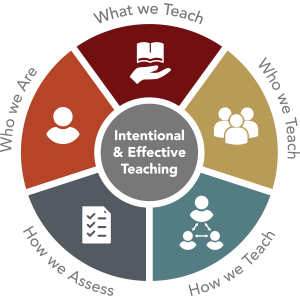- Home
- Center for the Advancement of Teaching & Learning
- Teaching for Equity and Inclusion
Teaching for Equity and Inclusion
 Teaching for Equity & Inclusion
Teaching for Equity & Inclusion
We work and teach on a campus populated by diverse students who experience our courses differently, based in part on their previous educational experiences, individual backgrounds and perspectives, abilities, and social identities.
Our students bring useful and varied knowledge and skills, resilience, and openness to engaging with new content and respectfully learning alongside others. To varying degrees, they may also be affected by the legacies of historic and systemic inequalities, racism, unequal access to resources, biases and stereotypes, and discriminatory and/or painful actions by others.
Some of the factors that affect our students are beyond our control, but there are meaningful actions we can take to promote equity and inclusion in our teaching.
Instructors who teach for equity and inclusion intentionally create learning environments where all students are treated equitably, so that all students have equal access to learning, and feel valued and supported in their learning. Inclusion means that all students feel invited to explore ideas, safe to express their views in a civil manner, and respected as individuals and members of groups.
At Elon, all community members share responsibility for inclusive excellence. Research demonstrates that inclusive and equitable classrooms can support rigorous academic work and deep learning. It also suggests there are many things faculty can do to help all students feel a sense of belonging and increase their chances for successful learning as we welcome, academically challenge, and support our students.
Where to Start?
To support efforts to effectively teach for equity and inclusion, this CATL website encourages instructors to intentionally consider the five areas below, which are also linked in the left-hand menu.
- Who we are: Our roles, values, assumptions, and identities affect our decisions about course content and pedagogy and our interactions with students. Considering these elements carefully can lead us to intentional, authentic, and effective teaching.
- What we teach: Course design involves many decisions about goals, topics, and materials to help students understand the knowledge, skills, challenges, and trends in our discipline and field, with the goal of stimulating critical thinking and engagement.
- Who we teach: Understanding the challenges and strengths that students bring to our courses increases our ability to engage, instruct, build rapport with, and support them, thereby increasing their motivation and capacity for learning.
- How we teach: We enact our goals, values, and commitments through day-to-day teaching strategies that can help us create a productive classroom environment, get off to a good start, set policies and course norms, handle difficult moments, and even determine what not to do.
- How we assess: Research informs us about methods for assessment and transparent assignment design that help level the playing field as well as practices to increase consistency, fairness, and student trust in our grading.
Resources
Looking to discuss the incorporation of diversity, equity, and inclusivity into your teaching? Reach out for an Inclusivity Pedagogy consult with CATL’s Pedagogy Fellow, Dr. Vanessa Drew-Branch.
Want a checklist of research-based inclusive practices? The University of Michigan Center for Research on Learning and Teaching provides one, along with explaining the research basis supporting inclusive teaching.
Looking to learn more about inclusive language? Check out this glossary of DEI terms from Elon’s Division of Inclusive Excellence.
Or download the Inclusive Teaching Guide from Columbia University.
Support our site
The purpose of this website is to provide resources to faculty members about teaching for equity and inclusion. It is an evolving site and suggestions are appreciated.
Do you have information to contribute or feedback on the site? Let us know at catl@elon.edu.